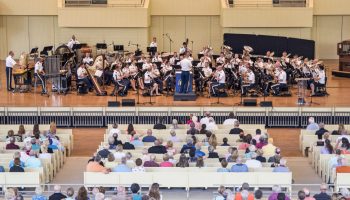Jeremy Bailenson’s course on virtual reality at Stanford University has a rather unusual required textbook: William Gibson’s 1984 sci-fi thriller, Neuromancer.
“In this book, Gibson talks about how virtual reality is going to change the nature of what it means to be a person,” Bailenson said. “It’s going to change social relationships. It’s going to change training and it’s going to change entertainment.”

Gibson laid out that vision in a fantasy world “dominated by crime, addiction and despair,” according to Bailenson. At 10:45 a.m. Thursday, Aug. 2, in the Amphitheater, Bailenson will articulate a somewhat sunnier vision for VR’s future in the real world.
Institution chief of staff Matt Ewalt thinks Bailenson will contribute an important voice to Week Six’s theme, “The Changing Nature of Work.”
“What’s often driving the conversation about the future of work is automation and how that will displace a number of workers,” Ewalt said. “But there’s also the question of how something like virtual reality will open up new ways of working. That’s significant, and it needs to be part of the dialogue alongside discussions about automation and such.”
Bailenson has been on the front end of VR for some time now: his first experience with the technology was in 1994 through the immersive video game “Dactyl Nightmare,” although most Americans in 2018 are still not using the technology.
But it wasn’t until Bailenson came across Neuromancer in his fifth year of graduate school that he decided to make VR his professional focus. After reading the book, Bailenson “sort of dropped everything” and began a journey that landed him at Stanford, where he is the founding director of the university’s Virtual Human Interaction Lab.
For Bailenson, it’s not just the headsets and sensors that make VR special — it’s the way VR technology reacts to the human body.
“If you’re playing a traditional video game, you’re hitting buttons or moving with arrow keys. In VR, when you want to get closer to an object, you just walk,” Bailenson said. “And hence, you’re activating the motor sensory cortex in the same way it’s been activated since people have been people.”
That physical interface allows people to develop dangerous or difficult-to-practice skills, Bailenson said, because it lets users make mistakes without risking anything. And that future is already here, according to Bailenson: fight simulation, one of the earliest forms of VR, has been successfully aiding pilots in learning how to fly for decades.
Bailenson is also using VR as a tool to create empathetic experiences by allowing users to experience life from new perspectives. This year, Bailenson collaborated with Columbia University professor Courtney Cogburn, who researches racism and health disparities, to produce “1000 Cut Journey,” an immersive VR experience that premiered at the 2018 Tribeca Film Festival.
“1000 Cut Journey” allows non-black people to experience racism from the perspective of a black man at different points in his life. The title refers to small instances of racism that people of color experience, often referred to as micro-aggressions.
In the first scene of the experience, the user is put into the shoes of a 7-year- old black boy, who is playing with blocks in a classroom with three other white children. When the user throws a block, the teacher singles out the user to reprimand, even though the other children were also throwing blocks.
The experience is intended to show non-black people what these micro-aggressions feel like. Bailenson found that first scene particularly effective.
“The application of different rules and norms throughout your lifetime is a powerful idea,” he said. “But for me, being that kid and sitting on that floor and having these other kids ostracize you — that has stayed with me the most.”
Bailenson tends toward optimism when it comes to VR, and he said his most recent book, Experience on Demand, received criticism for not being wary enough of the technology’s downsides. But Bailenson will begin this morning’s lecture with a discussion of those problems and possible solutions, he said.
Distraction and addiction are two particular problems that must be addressed. VR, Bailenson said, is the most distracting medium ever designed — and because of how intense the experiences can be, users are prone to becoming addicted.
“When social networking feels like the best party you’ve ever been to, when online gambling feels like you’re actually in Las Vegas,” Bailenson said, “(we have to be asking) how we break out of these experiences.”
But despite the potential drawbacks, Bailenson is trying to wield VR as a tool for solving cultural problems and advancing society. He expressed his commitment in an op-ed for the San Francisco Chronicle earlier this year:
“I have chosen to leverage the intensity of this medium for good, focusing on how VR can reduce prejudice, improve training and education, increase environmental conservation and help people heal from physical and mental wounds.”




